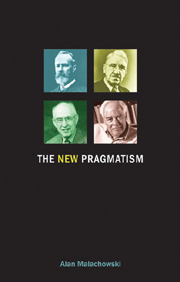Book contents
- Frontmatter
- Contents
- Preface
- Acknowledgements
- Abbreviations
- 1 Introducing the New Pragmatism
- 2 Leaving classic pragmatism behind
- 3 Rorty against the tradition
- 4 Putnam's contributions
- 5 Putnam and Rorty: pragmatism without reconciliation
- 6 Prospects
- Conclusion: the New Pragmatism and philosophy
- Notes
- Reading the New Pragmatists
- Bibliography
- Index
5 - Putnam and Rorty: pragmatism without reconciliation
- Frontmatter
- Contents
- Preface
- Acknowledgements
- Abbreviations
- 1 Introducing the New Pragmatism
- 2 Leaving classic pragmatism behind
- 3 Rorty against the tradition
- 4 Putnam's contributions
- 5 Putnam and Rorty: pragmatism without reconciliation
- 6 Prospects
- Conclusion: the New Pragmatism and philosophy
- Notes
- Reading the New Pragmatists
- Bibliography
- Index
Summary
Putnam thinks that my radical version of pragmatism gives rise to pointless paradoxes – that it saves us from the frying pan of what he calls “metaphysical realism” only to throw us into the fire of relativism.
(Richard Rorty, “Hilary Putnam and the Relativist Menace”)Putnam and Rorty argued with one another for over a period of about thirty years. That debate sheds some important light on the New Pragmatism. For it shows how the two thinkers most responsible for reviving interest in a pragmatist approach to philosophy diverged in their beliefs as to what that approach should involve. Furthermore, this disagreement is in many ways more instructive than those between the proponents of the New Pragmatism and their external critics. For these are always liable to deteriorate into the kind of sterile, energy-sapping contests that stifled classic pragmatism.
In this chapter, we shall review certain aspects of the debate, including a number of the primary texts that it generated, and some of the related commentary. We then conclude that the New Pragmatism can thrive without reconciling all the differences between Putnam and Rorty. This in itself indicates the robust, self-critical and flexible nature of the New Pragmatism.
Difference despite agreement
There is an immediately apparent asymmetry in the Putnam–Rorty debate. Putnam maintains that Rorty's pragmatism is fundamentally flawed, and spends far more time trying to establish those flaws than in elucidating or revising his own views in response to Rorty's replies.
- Type
- Chapter
- Information
- The New Pragmatism , pp. 83 - 98Publisher: Acumen PublishingPrint publication year: 2009



